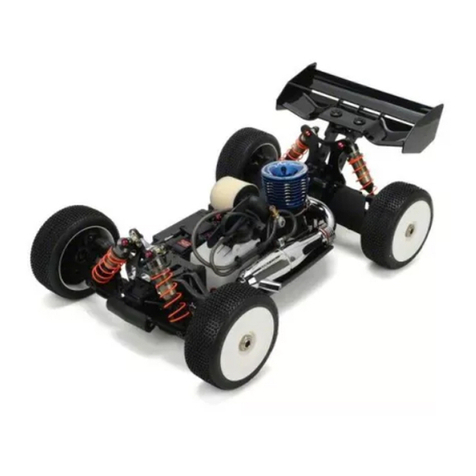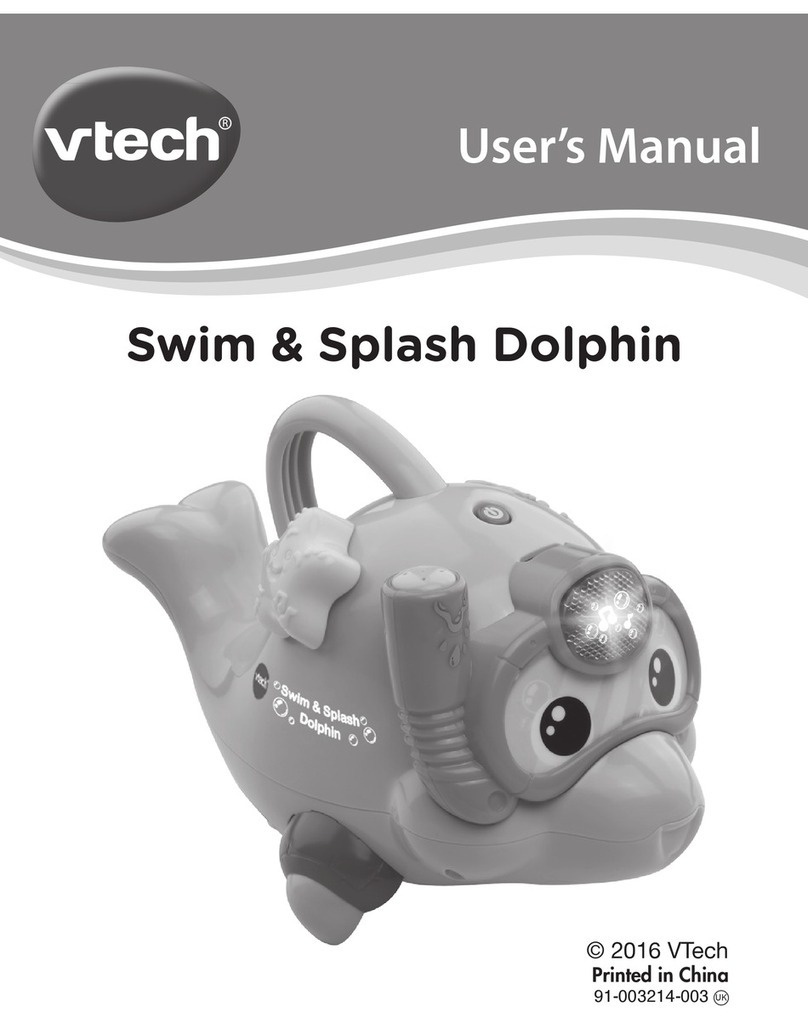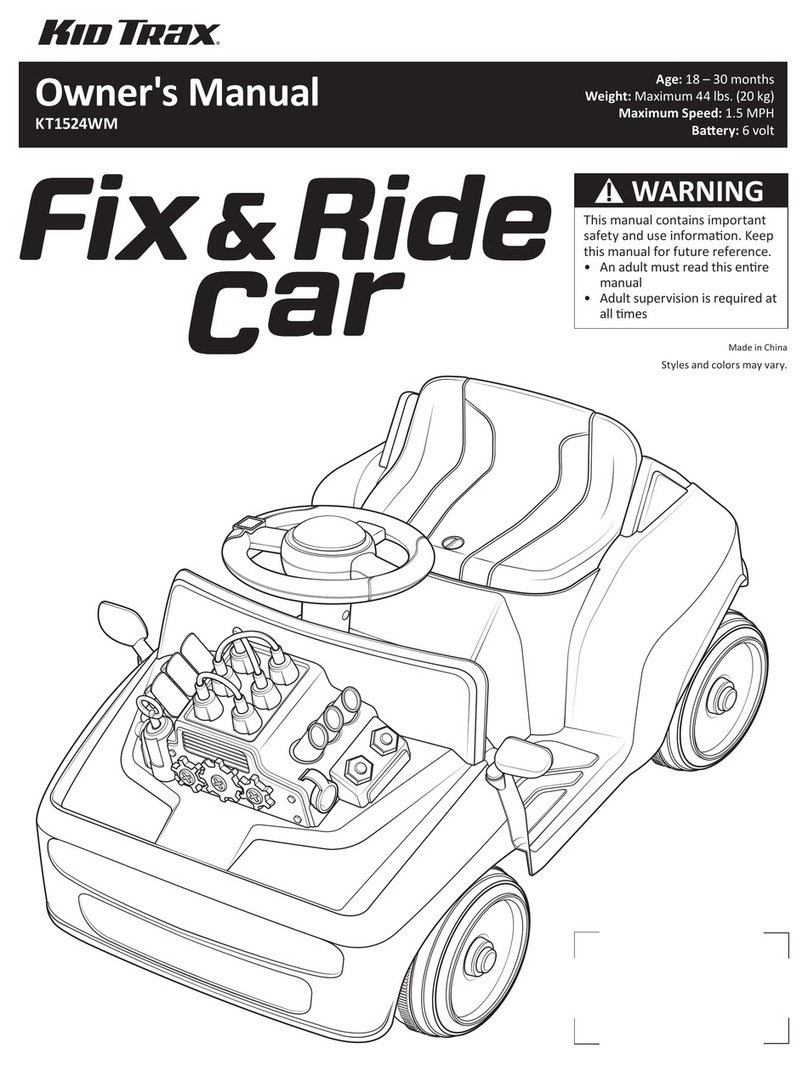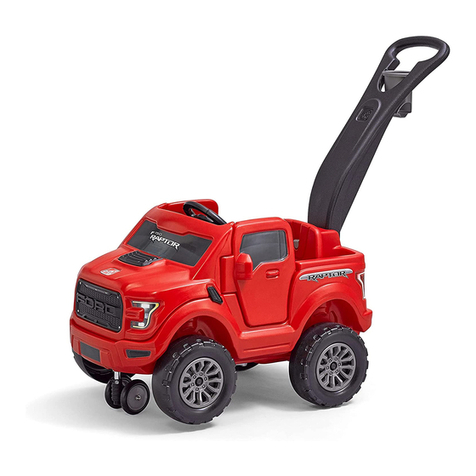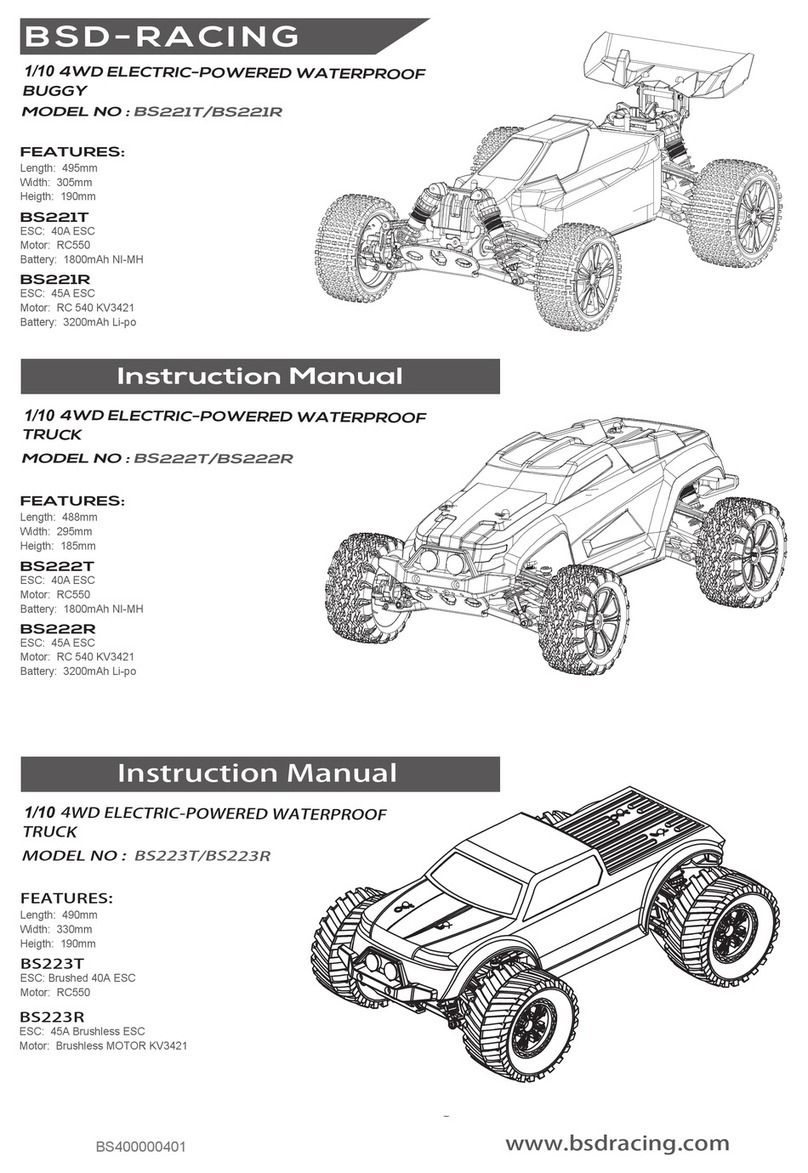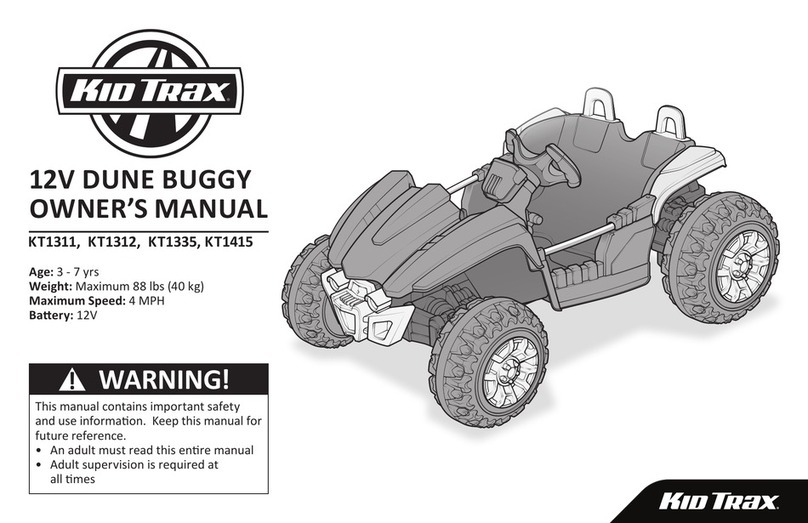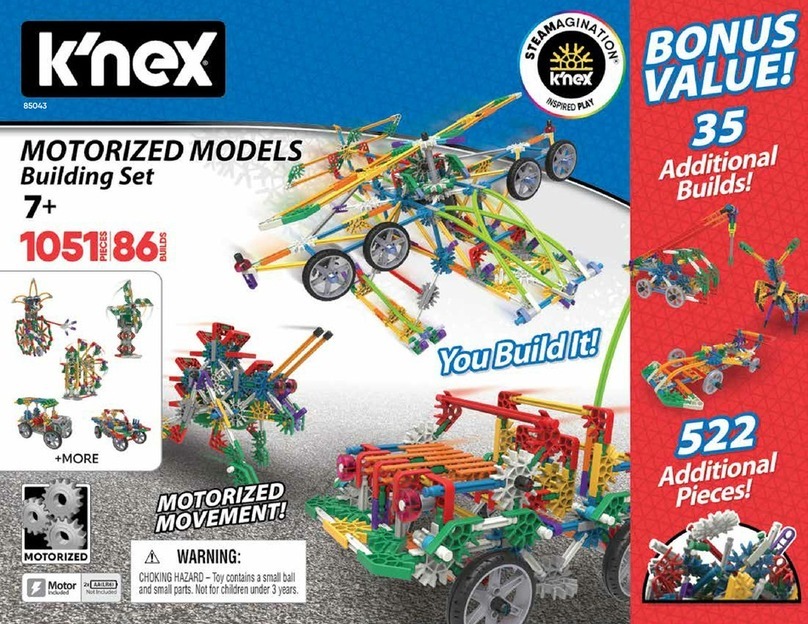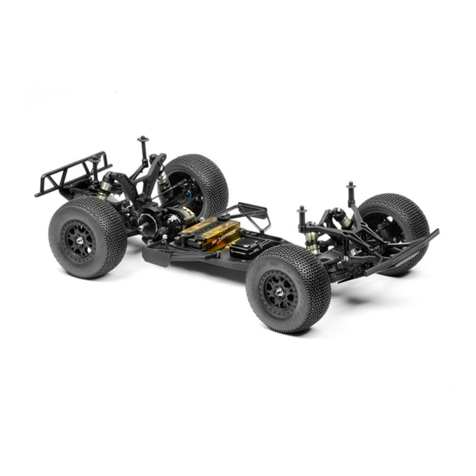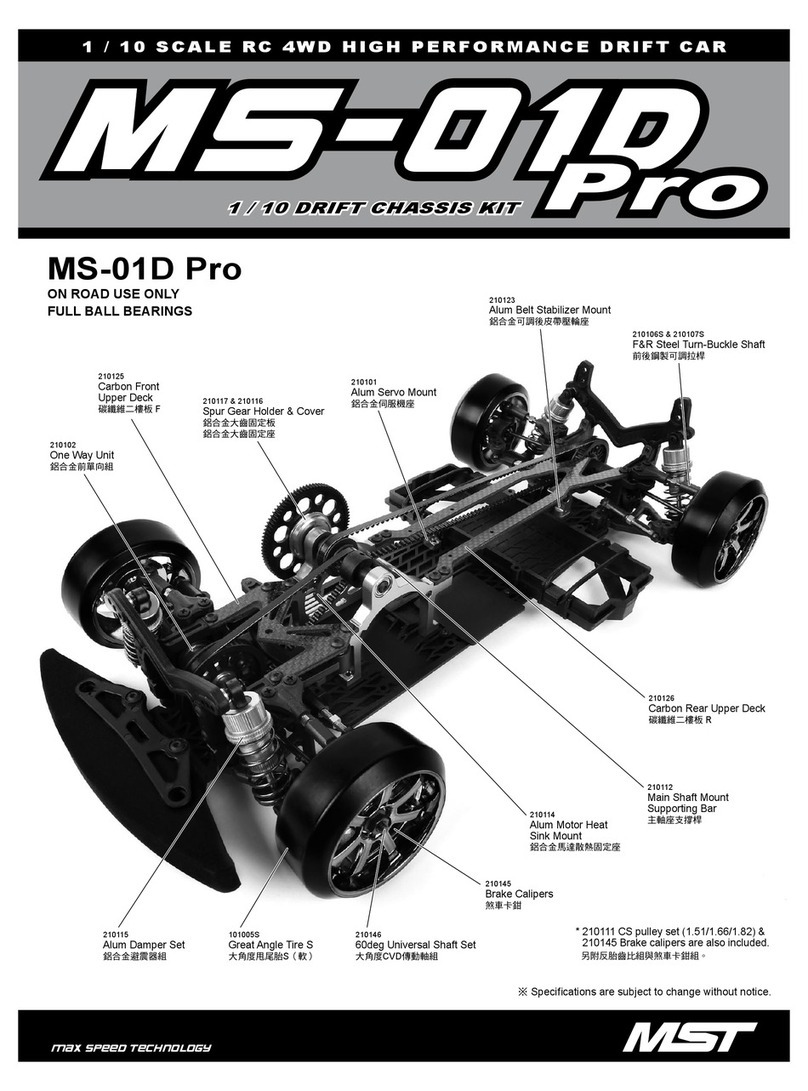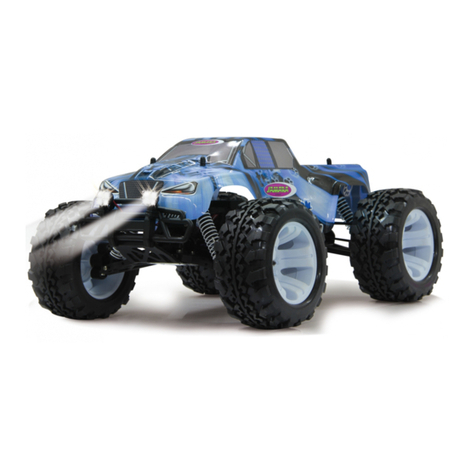rollzone CHEVROLET CAMARO 2SS User manual

N
E
AGES 3+
MODEL NO.
HL558
|
Chevrolet Camaro 2SS
OWNER’S MANUAL
Please read entire manual before starting assembly.
Keep this manual along with your purchase receipt
for future reference.
mGENERAL MOTORS TRADEMARKS USED
gm UNDER LICENSE TO JIAXING HARLEY
BABY CAR COMPANY LIMITED
OFFICIAL
|
Contents, colors and decorations may vary from those shown.
LICENSED PRODUCT
AWARNING: AWARNING:
CHOKING HAZARD-Small parts.
bea Toy must be assembled by adult before use.
Screws contain potentially To reduce the risk of injury, adult supervision
-is required. Never use on road ways, near
hazardous sharp points or motor vehicles, on or near steep inclines or
sharp edges. Adult assembly steps, swimming pools or other bodies of
required. water. Always wear shoes, and never allow
more than onerider. -

IMPORTANT
You must charge your battery
for 12 hours before you use your
vehicle for the first time.
Remember to. ..
vCharge the battery immediately after each use.
vCharge the battery at least once a month during storage,
even if the vehicle has not been used.
The battery will be permanently damaged and void your warranty if you fail to follow the
instructions. Please refer to the Battery Care Section in this manual for more information.
J
TTOREAl LCOS IEAT)
®Your new vehicle requires adult assembly. Please set ®To prevent damaging the motors and gears, do not tow
aside at least 30 minutes for assembly. anything behind the vehicle or overload it. Do not exceed
®You must charge your battery for 12 hours the maximum weight capacity of 55 Ibs (25kg).
before you use your vehicle for the first time. We
recommend that you start charging your battery
before beginning assembly. Please see Battery
charging beginning on page 6for detailed instructions.
®Read this manual carefully for important safety
information and operating instructions before using
your vehicle. Keep these instructions for future
reference as they contain important information.
®This vehicle is designed for use on: concrete, asphalt
or other hard surfaces; on generally level terrain; by
children ages 3 and up.
Instruct the children on operation and safe driving
rules before they take their first drive:
-Always sit in the seat.
-Always wear shoes.
-Only one (1) rider at atime.
-Do not place hands, feet or any part of the body,
clothing or other articles near moving parts while
the vehicle is in operation.
-Do not allow other children near the car when driving.
®Use this vehicle ONLY outdoors. Most interior
flooring can be damaged by riding this vehicle indoors.

Warning
To Prevent Serious Injuries
®This product is intended for use by children ages
3and up, and is not intended for children under 3
years of age due to lack of ability to operate safely.
®Maximum weight 55 Ibs (25 kg). Maximum 1
rider at atime.
Do not leave children unattended. Adult
supervision required.
This package contains small parts. Keep away
from the children until assembled.
Read manual for detailed safety information prior
to use.
Inspect product at regular intervals for wear or
loose hardware and tighten as required. Remove
from service if any abnormal conditions such as
cracks or breaks exist.
Check all coverings regularly to make sure
they are in place.
Safe Driving Rules
®ADULT SUPERVISION REQUIRED.
MAKE SURE CHILDREN KNOW AND
FOLLOW THESE RULES FOR SAFE
DRIVING.
®Restrict children to safe riding areas:
=m Away from swimming pools and other bodies of
water to prevent drowning.
~m Level ground to prevent tipovers and unintended
downhill motion.
=Away from steps, hills, driveways, roads and alleys.
®Teach and learn the safety first:
Although most children can master the physical
driving skills to control the vehicles, they do not have
the mature judgment skills. Never let achild drive at
any time without adult supervision, and take the time
to carefully evaluate child's skill levels and abilities
to operate the vehicle safely. Children can not always
recognize the hazards even after instruction. So teach
appropriate safety rules before allowing any child to
operate vehicle, and remember that THERE IS NO
SAFE SUBSTITUTE FOR DIRECT ADULT
SUPERVISON.
®Batteries can fall out and injure achild if the
vehicle tips over. Always use the battery
cover.
When the temperature falls below 0°F(-18°C),
outdoor use of this product is not recommended.
®|n extreme cold, plastic materials might lose
resilience and may become brittle and crack ®Riding rules:
upon impact. Store in awarmer and protected
place.
Do not operate the vehicle outdoors if it is
raining. Keep it in a dry area when not in use.
Disconnect the battery power supply when
the vehicle is not in use to prevent the children
driving the car without adult supervision.
Always make sure the seat is securely attached.
The charger and battery are not toys and must
be regularly examined for damage to the cord,
plug, enclosure and other parts.
In the event of damage, the damage or worn
part must not be used until replaced.
Never modify the electrical system. Use of the
wrong type battery or charger could cause a
fire or explosion.
The battery compartment and area under seat
are not storage areas. Storing other articles may
create afire hazard. Do not store any articles
in or near motor compartment.
®Always sit on the seat and wear shoes.
®Maximum one rider at atime.
aDo not operate in the street or near moving vehicles.
=Do not operate near bodies of water, obstructions or
drop-offs.
=Do not operate on sand, dirt or gravel.
=Do not operate in the dark. Unexpected obstacles
could cause an accident.
®Do not operate on inclines or steep slopes.
=Do not operate near flammable vapors (e.g. gasoline,
paint thinner, acetone, liquid wax, etc.) Using the vehicle
near flammable liquids can or vapors could cause an
explosion or fire.
=Do not place anything near moving parts such as
motors, gears or wheels. Rotating parts can snag
hair, fingers, etc., which may cause serious injury.

ELECTRICAL HAZARD
Battery can fall out and injure achild
if vehicle tips over. Always use battery
cover.
PREVENT FIRE
-Never modify the electrical system.
Alterations could cause afire resulting.
In serious injury and could also ruin the
electrical system.
-Use of the wrong type battery or
charger could cause a fire or explosion
resulting in serious injury.
®The battery must be handled by adults
only. The battery is heavy and contains
sulfuric acid (electrolyte). Dropping the
battery could result in serious injury.
eNever allow children to charge the battery.
Battery charging must be done by adults
only. Achild could be injured by the
electricity involved in charging the battery.
eo Never lift or carry the battery by the wires
or connector. This can damage the battery
and possibly cause afire resulting in
serious injury. Lift and carry the battery
by the case only.
®Read the safety instructions on the battery.
®Examine the battery, charger and their
connectors for excessive wear or damage
each time you charge the battery. If
damage or excessive wear is detected, do
not use the charger or the battery until you
have replaced the worn or damaged part.
PTR gE
CAUTION
A
Only use the charger in dry locations.
About Thermal Fuses
®Your 12 volt battery is equipped with abuilt-in
thermal fuse. The thermal fuse is a self-resetting safety
device which automatically trips and shuts down operation
of the vehicle if the vehicle is overloaded or the driving
conditions too severe. Once afuse has tripped it will
automatically resetitself after approximately 10 seconds
and allow the vehicle to resume normal operations. To
avoid repeated automatic shut downs, do not overload
the vehicle by exceeding the 55 Ibs (25 kg) maximum
weight capacity or by towing anything behind the vehicle.
Avoid severe driving conditions, such as driving up very
steep slopes or running into fixed objects, which can
cause the wheels to stop spinning while power is still
being supplied to the motors.
Important Notes
®Your new battery must be charged for at least 12 hours
before you use it in your vehicle for the first time.
@You do not need to remove the battery from your
vehicle to recharge it.
®The battery must be upright while charging.
®The charger is not atoy.
®Do not short circuit the battery.
©We recommend that you start charging your battery
before beginning assembly of your new vehicle.
®Before charging the battery, examine the battery case
for cracks and other damage which may cause sulfuric
acid (electrolyte) to leak during the charging process.
®|f damage is detected, do not charge the battery or
use it in your vehicle. Battery acid is very corrosive and
can cause severe damage to surfaces it contacts.
®Do not charge the battery on a surface which could be
damaged by the acid contained inside the battery. Take
precautions to protect the surface on which you charge
your battery.
®|f your battery is old and will not accept a charge, do not
leave it in the vehicle. Always remove a dead battery
from the vehicle.
®Non-rechargeable batteries are notto be recharged.
®Rechargeable batteries are only to be charged under
adult supervision.
®Only batteries of the same or equivalent type as
recommended are to be used.
®Batteries are to be inserted with the correct polarity.
®Exhausted batteries are to be removed from the toy.
©The supply terminals are not to be short-circuited.

Battery Warning
ACAUTIO N©Make sure the brand, voltage and frequency of the
chargers are in accordance with the wall outlet.
®Non-rechargeable batteries are not to be recharged. =¥=i
©Batteries are to be inserted with the correct polarity.
®Make sure the charger connector is matching with
the battery connector. ®The supply terminals are notto be short circuited.
Charge the battery :
The first charge will take about 12 hours.
1. Charge the battery directly from the 2. Take out the battery. Charge the battery
socket near the seat. independently.
®Plug the battery connector into the charger port.
®Plug the charger into astandard wall outlet.
eOnly use the 12 volt charger to charge your 12 volt battery.
®Note: If Power flow to the wall outlet is controlled by aswitch, make sure the switch is "ON".
®Before first-time use, charge the battery for at least 12 hours. Never charge the battery longer than 24 hours.
eRecharge the battery for at least 8-10 hours after each use of your vehicle.
eDo not charge the battery longer than 24 hours.
®Do not charge or store the battery upside down. Charging produces may explosive gases. Charge away from
flames, sparks and lit cigarettes. Charge in awell-ventilated area.
Once the battery is charged, disconnect the battery connector from the charger connector. Unplug the
charger from the wall outlet. The battery is now ready to be installed to your vehicle.
Battery replacement -
1. Lift the seat out
2. Disconnect the battery connectors
3. Remove the 4screws on the sides of the battery
4. Take out the battery from the battery compartment

Battery Care and Disposal
Care Disposal &:X
©If abattery leak develops, avoid contact with the ®Your battery is asealed lead-acid battery.
leaking acid and place the damaged battery in aIt must be recycled or disposed of it in an
plastics sealed bag.
]environmentally sound manner.
oIf acid comes in contact with skin or eyes,flush with ©Never dispose your battery in the regular, household
cool water for at least 15 minutes and call aphysician trash. The incineration, landfilling or mixing of sealed
immediately. lead-acid batteries with household trash is prohibited
©If acid is internally ingested, give water, milk of magnesia by law in most areas.
or egg whites immediately. Never give emetics or induce eAlways remove exhausted batteries from your toy.
vomiting. Call aphysician immediately. ®Dispose of dead batteries properly, Never burn or
®Charge anew battery for at least 12 hours before first bury them.
use. ©Do not dispose of alead-acid battery in afire. The
®Never charge the battery longer than 24 hours. battery may explode or leak.
®QOvercharging or undercharging the battery may shorten
battery life and decrease vehicle running time.
©After the first charge, recharge the battery for at least 8-
10 hours after each use. Never charge the battery longer
than 24 hours. Charge the battery after each use,
regardless of how long the vehicle was used.
©The battery must be upright while charging.
©Do notallow the battery to run down completely
before charging.
©Charge the battery before storing the vehicle.
Charge the battery at least once per month, even if the
vehicle has not been used.
eo Leaving the battery in adischarged condition will
ruin it.
oIf the vehicle will be stored for more than two months,
be sure to disconnect the motor hamess from the
battery.
©Do not store the battery in temperatures above 75° F
or below-10° F.
©Prevent the battery from moving freely inside the battery
compartment. Make sure all screws for battery cover
tighten.
©Examine the battery, charger and its connector for
excessive wear or damage each time you charge the
battery. If damage is detected, do not use the charger
or the battery until you have replaced the wom or
damaged part.
®Remember to remove an exhausted battery from the
vehicle.
®Battery leakage and corrosion can damage the vehicle.
TO PROLONG BATTERY LIFE, YOU MUST RECHARGE THE
BATTERY AFTER EACH USE. YOU MUST ALSO CHARGE
YOUR BATTERYIF IT HAS NOT BEEN USED FOR 30 DAYS
OR MORE.

VB
oPlease identify all parts before assembly and save all packaging material until assembly is completed to
ensure that no parts are discarded.
Metal parts have been coated with lubricant for protection during shipment. Wipe all metal parts with a
paper towel to remove any excess lubricant.
Main body x1Steering wheel x1Charger x1
Rear wheel x2Front wheel x2Wheel cover x4 Side bracket
Lx1 Rx1
Spoiler x1Side mirror x2Rear racket x1
~~
Windshield x1
Manual
Washer x4Washer x2Manual x1
(8 x1.3mm) (12 x1.5mm)
Socket tool x2Screw x22 Screw x2
(4 x12mm) -(3.5 x12mm)
Remote Control Operation. please read the attached manual separately.

Assembly
Insert the side support and fasten with 7
screws. Repeat the same procedures for
the other side.
Washer
(12x 1.5mm) Front wheel Wheel cover
|
va
Front wheels: Assemble all the parts in
sequence as picture and use the socket t
ool to fasten. Repeat the same procedures
for the other side.
“Snap” the wheel cover into the right place.
Repeat the same procedures for the other
three wheels.
Insert the rear support and fasten with
9screws.
@
Washer Nut
(8x13mm) (M8)
Rear wheels: Assemble all the parts in
sequence as picture and use the socket
tool to fasten. Repeat the same procedure
for the other side.
“Snap” the tabs on the spoiler into the
slots in the rear top side of vehicle.

Assembly
Plug connectors, place the steering “Snap” the tabs on the windshield into
wheel into the turning shaft. the slots in the front top side of the vehicle.
Insert ascrew and tighten. Repeat the same
procedures for the other side.
Battery assembly: Plug connectors as “Snap” the tabs on the seat into the
the picture. slot of the vehicle.
“Snap” the tab on the side mirror into
the slot. Repeat the same procedures
for the other side.

0)31aiTill)yMele
Power switch
Switch button ON and OFF.
Forward
Push the shifter in upward position and press the
accelerator slowly.
Reverse
Push the shifter in downward position and press the
accelerator slowly.
Low speed
Vehicle has been pre-set to operate at low speed
(1.5 mph, (3.0 kmh) maximum). Once your child
has mastered safe driving skills and understands
the Safe Driving Rules.
High speed
Vehicle to be driven at the higher speed (2 mph,
(3.5kmh) maximum) Make sure your child can safely
steer and operate the vehicle and knows the rules
for safe driving.
Stop
Vehicle will automatically stop after the accelerator is
released.
Sound effect
Press the buttons on the sides ofthe steering wheel:
Each button will make adifferent sound effect.
Safety device
AUTO POWER OFF. If the motor is overloaded for
any reason, including improper usage, an electrical
circuit breaker will automatically cut off the power,
then resume after the parts have cooled!
Maintenance
eClean with a dry, soft cloth only. Do not wash
with water or corrosive agents.
e Store vehicle in adry area when not in use,
since moisture could cause the metal
components and electrical parts to corrode.
®Remember to charge the battery monthly while
the vehicle is not in regular use.
eCheck and tighten all screws and coverings
regularly.
eCheck all plastic parts for cracks. Replace as
necessary.

Troubleshooting
Problem Possible Cause Solution
Car does not move Circuit breaker tripped Circuit breaker may “trip” and stop the vehicle if it is overloaded or the
driving conditions too severe. The breaker will automatically reset after
approximately 10 seconds, and the vehicle will operate normally. To avoid
repeated automatic shut downs, do not overload the vehicle by exceeding
the weight limited of 55 Ibs(25kg). Or by towing anything behind the vehicle.
Do not drive up hills or run into fixed objects, which can cause the wheels to
stop spinning while power isstill being supplied to the motors. If breaker
continually trips, contact your service center.
Loose wire or connectors Check all wires and connectors. Make sure that the motor harness
connector is plugged in tightly to the battery, and that there are no
loose wires around the motor.
Dead battery An old or improperly cared battery may be dead. If you are unsure
whether it is dead or not, you can have it tested at your Service
Center.
Undercharged battery Anew battery should have been charged for at least 12 hours before
using the vehicle for the first time. After that, it must be recharge the
battery for at least 8-10 hours after each use. Never charge longer than
24 hours. Check all connectors; make sure the charger is plugged into
the wall. Make sure the power flow to the outlet is on.
Charger is not working You must have avolt meter in order to tell whether the charger is
working or not. If you think there maybe a problem with the charger ,
takeit to the service center where they will test it for you.
Damaged switch When to water or
or can jam due to loose dirt, sand or gravel.
Contact your service center for diagnosis and repair.
can become 3
Car was running but
suddenly stopped
Loose wire or connectors Check all wires and connectors. Make sure that the motor hamess:
connector is plugged into the battery tightly, and that there are no
loose wires around the motor.
Circuit breaker tripped Circuit breaker may “trip” and stop the vehicle if it is overloaded or
the driving conditions too severe. The breaker will automatically
reset after approximately 10 seconds, and the vehicle will operate
To avoid rep
ido not
the vehicle by exceeding the weight limited of 55 Ibs (25kg), or by towing
anything behind the vehicle. Do not drive up hills or run into fixed
objects, which can cause the wheels to stop spinning while power
is still being supplied to the motors. If breakercontinually trips,
contact your service center.

Troubleshooting
Problem Possible Cause Solution
Short operating time (less
than 1hours per charge)
Undercharged battery Anew battery should have been charged for at least 12
hours before using the vehicle for the first time. After
that, it must be recharge the battery for at least 8-10 hours
after each use. Never charge longer than 24 hours. Check all
connectors; make sure the charger is plugged into the wall.
Make sure the power flow to the outlet is on.
Overcharged battery Never charge battery longer than 24 hours. If you think
the battery maybe damage due to overcharging, contact
service center for testing.
Old battery will not accept afull charge Even with proper care, arechargeable battery does not
last forever. Average battery life is 1to 3 years depending
on vehicle use and use conditions. Replace the battery
with anew volt rechargeable battery. Do not substitute parts.|
To get areplacement battery, please contact service
center
Vehicle is sluggish Undercharged battery Anew battery should have been charged for at least 12
hours before using the vehicle for thefirst time. After that,
it must be recharge the battery for at least 8-10 hours after
each use. Never charge longer than 24 hours. Check all
connectors; make sure the charger is plugged into the wall.
Make sure the power flow to the outlet is on.
Battery needs charging Be sure to chargethe battery after each use.
Old battery will not accept afull charge Even with proper care, arechargeable battery does not
last forever. Average battery life is 1to 3 years depending
on vehicle use and use conditions. Replace the battery
with a new rechargeable battery. Do not substitute parts.
To get areplacement battery, please contact service
center.
Vehicle is overloaded Allow no more than 1rider at atime, follow the
55 Ibs (25kg )weight capacity and don't tow anything
behind the vehicle.
Driving conditions are too stressful Use only on agenerally level ground.

Troubleshooting
Problem Possible Cause Solution
Intermittent vehicle operation Loose wire or connector Check all wires around the motors and all connectors
to make sure they are tight.
Motor or electrical switch damage Contact your service center for diagnosis and repair.
When the accelerator is
pressed, the vehicle won't
run without a push
Loose wire or connector Check all wires around the motors and all connectors
to make sure they are tight.
“Dead Spot” on motor Contact your service center for diagnosis and repair.
Motor gear box makes aloud
grinding or clacking noise
Broken gears Contact your service center for diagnosis and repair.
Charger get warm during use This is normal and should not
be concern.
No action required.
Battery makes gurgling or
sizzling noise while charging
Some noise and swelling is normal
and should not be a concern
No action required. If the battery does not make noise
while charging. It does not mean it isn't accepting the
charging.

Parts Diagram
Note: Some parts shown are assembled to both sides of the vehicle.
Quantity Quantity
1. Front End Assembly .Gear Box 17. Seat
2. Side Support Bracket 10. Rear Wheel Assembly 18. Side Mirror
3. Front Steering Assembly 11. Rear Axle 19. Steering Wheel
4. JHook
5. Front Support Bracket
6. Front Wheel Assembly
7. Wheel Cover
8. Battery Assembly
12. Main Body
13. Rear Support Bracket
14. Tail Light Assembly
15. Rear Panel Assembly
.Spoiler
20. Dashboard Assembly
21. Windshield Assembly
22. Hood
A
Tt
kr
Uy
eae
RS
(IE
EA
BIND
WE
INS

Instruction for 2.4G Remote Control of Electric Ride-on Car
BFeatures
-Supply Voltage: 2X1.5V
-Frequency: 2.4GHz
B® Button Description
Forward Paring Speed
Backward
Speed indicator light
-Forward: Direct the ride-on car to move forward
-Backward: Direct the ride-on car to move backward
-Paring: Pair the ride-on car with aremote controller
-Left: Direct the ride-on car to turn left
-Right: Direct the ride-on car to turn right
-Speed: Adjust the speed of the ride-on car's movement as low, moderate or high
-Brake: Immediately stop the ride-on car and lock the car until released
®Pairing Instruction
1. Turn on the powerof the ride-on car, press and hold the pairing button until the speed
indicator light switches on without flashing
2. Release the pairing button, and the speed indicator light will switch off
3. If the speed indicator light switches on again, then the pairing is successful; if not, please
repeat steps 1and 2
4. One successful pairing is all, and no more pairings are needed in later use
®Battery installation
Open the back cover of the remote control with screwdriver and insert two triple Abatteries
(AAA 1.5V). Please pay attention to the polarity. Close the back cover and tighten the screws
when the LED light is on, indicating battery installed properly.
Battery needs to be replaced when the LED light dims or blinks.

Universele handleiding
elektrisch rijdend speelgoed
(versie juli 2020)
Montage:
Te Controleer voordat uaan de slag gaat met de montage van uw kinderauto, quad of kindermotor of alle
onderdelen volledig zijn. Ukunt alle onderdelen terugvinden op de figuren/foto’s op de Engelstalige
handleiding. Onderdelen kunnen overal verstopt zijn, namelijk onder het zitje, motorkap of onderaan het
chassis;
Het kan voorkomen dat ueen aantal stappen over kunt slaan doordat onderdelen af fabriek al voor
geinstalleerd zijn. Doordat elektrische kinderauto’s, quads en kindermotoren steeds meer opties krijgen
kan het voorkomen dat bepaalde opties of onderdelen niet of anders worden afgebeeld of omschreven.
Uiteraard kunt u bij vragen of voor meer inlichtingen altijd terecht bij uw leverancier;
Sluit de rode accu kabel op de rode accupool aan. De zwarte accu kabel is vrijwel altijd af fabriek al
aangesloten. De accu(‘s) vindt ubij de meeste modellen onder het zitje. In sommige gevallen is de accu
onder de motorkap geplaatst;
Sluit de accu kabels op de juiste accupolen aan. Rode kabel op de rode accupool en de zwarte kabel op
de zwarte accupool. Soms worden af fabriek plastic hoesjes op de accupolen geplaatst. Deze dient u
dus te verwijderen al voordat ude kabels op de accu aansluit;
Plastic hoesjes verwijderen Rode accupool Zwarte accupool
5. Let op: bij een 12 volt variant met 2x 6 volt accu’s heeft uin totaal 4accupolen. Namelijk 2 rood en 2
zwarte polen. Af fabriek zullen 3 van de 4accupolen bezet zijn. Uzult dan enkel de losse rode kabel op
de rode accupool moeten aansluiten;

zekering zekering
rode accupool
6. Schuif het achteras (indien het nog niet is voor gemonteerd) aan de onderkant achteraan het chassis
door de daarvoor bestemde gaten;
achteras
7. Heeft uw kinderauto steuntjes voor de voor en achter bumper, en voor beide zijkanten, en zijn deze niet
voor gemonteerd, dan dient udeze met de meegeleverde schroeven vast te zetten;
8. Schuif de aandrijving(en) op de achteras en zorg ervoor dat de kabels met de connector(en) en de
elektromotor via het grotere gat in de auto onder het zitje zichtbaar zijn. Let op: beide aandrijvingen zijn
meestal aangeduid met een sticker “L” voor links en “R” voor rechts. In dat geval moet u bij de montage
daar rekening mee houden;
9. Klik de connector van de aandrijving in de daarbij passende connector die onder het zitje is. Heeft ueen
model met 2aandrijvingen, dan zult beide aandrijvingen moeten aansluiten;

Connector
in de auto
(onder het zitje) ¥
Connector 7
aandrijvig
10. Heeft ueen model met slechts een aandrijving, dan kunt uook slechts een aandrijving aansluiten. Er
wordt dan in de Engelstalige handleiding afgebeeld aan welke kant ude aandrijving dient te monteren;
Aandrijvingen’
11. De volgorde van montage van de aandrijving, achterwielen en voorwielen zijn als volgt. Let op: Udient
de moeren niet te hard vast te zetten. Beide voorwielen moeten nog vrij kunnen ronddraaien. Kleine
speling op de wielen is gebruikelijk;
12.Heeft uborgpennen i.p.v. moeren, dan dient ude borgpennen in de gaten van alle uiteinden van het
achteras en vooras te plaatsen en deze zoals hieronder afgebeeld te buigen. Gebruik altijd een sluitring.
Hiermee worden de wielen goed geborgd;

ie
13.Heeft ueen model met borg knijpertjes, dan dient ude wielen met de meegeleverde knijpertjes vast te
zetten. Gebruik altijd een sluitring;
14.Heeft ueen model met borgdoppen, dan dient ude wielen met de meegeleverde doppen vast te zetten.
Gebruik altijd een sluitring;
15.Heeft uwielen met een klik systeem, dan zijn de wielen simpel te monteren door ze over het voor en
achteras heen te schuiven tot dat ze vastklikken. Wielen eraf klikken gaat d.m.v. het drukknopje op het
midden van het wiel;
Aandrijving
Wiel met kik
systeem
16. Voor een aantal modellen geldt dat ude stuurstang zelf op de stuurmotor moet aansluiten. Hierbij het
meest veorkomend model;

A. Plaatst de tandwieladapter ‘1’ in de stuurmotor zoals hierboven afgebeeld;
B. Schuif de lange rechte zijde van de stuurstang ‘2’ door de ronde gaten van de tandwieladapter
en de stuurmotor zoals hierboven afgebeeld. De stuurstang monteert udus aan de onderkant
van de auto en schuift uhelemaal naar boven door de opening in het dashboard;
C. Udient de tandwieladapter ‘1’ vast te zetten op de stuurstang ‘2’ d.m.v. de meegeleverde bout
en moer ‘3’. Dat is erg belangrijk. Hierdoor draaien de wielen naar links/rechts zodra ude auto
met de afstandsbediening gaat besturen;
D. Plaats de gebogen uiteinde van de stuurstang in de opening van de vooras zoals hierboven
afgebeeld bij nr. ‘4’ en borg het met de meegeleverde sluitring en borgpen ‘5°. Buig de borgpen
zodanig dat de stuurstang niet meer door de opening kan gaan.
17.Monteer het stuur op de stuurstang zoals hieronder afgebeeld;
A. Hangt er aan de onderkant van het stuur een connector met kabels, dan dient udeze aan te
sluiten op de connector die uit het dashboard komt; -
B. Indien er batterijen in het stuur moeten om geluidsknopjes te laten functioneren, dan kunt uhet
deksel openschroeven om batterijen in te plaatsten.
9
RB
Stuurstang
18. Monteer daarna alle resterende onderdelen zoals in het Engelstalige handleiding afgebeeld. Dat zijn dan
de spiegels, voorruit, zitje, spoiler, enz. (indien van toepassing en indien nog niet voor gemonteerd);
This manual suits for next models
1
Table of contents
Languages:
Popular Motorized Toy Car manuals by other brands
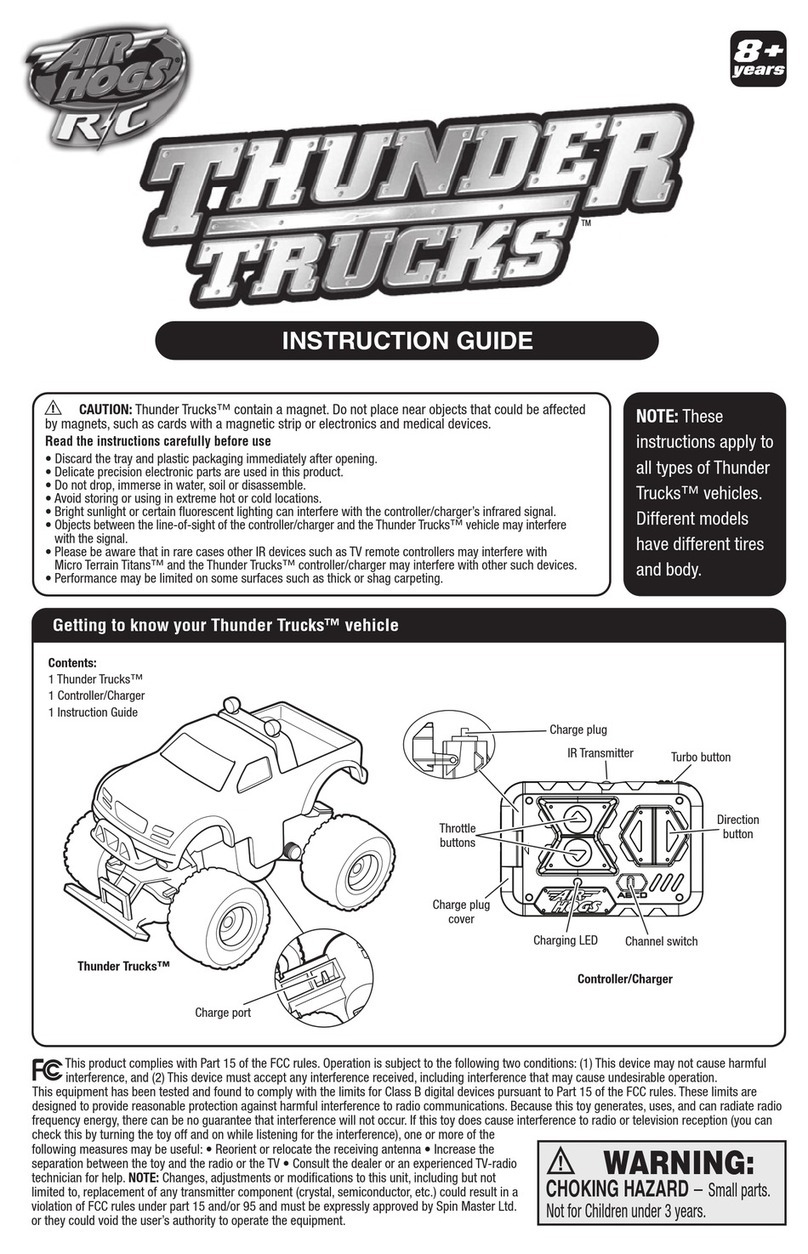
Air Hogs
Air Hogs Thunder Trucks Instruction guide
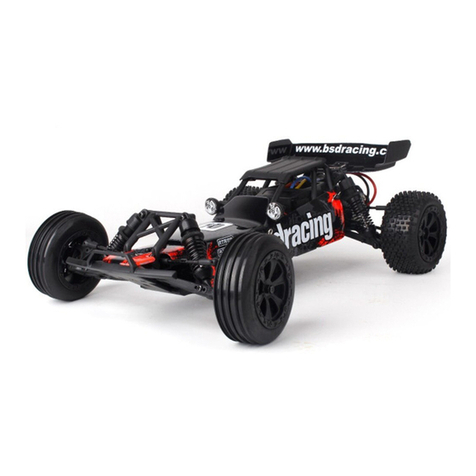
BSD-Racing
BSD-Racing BS709T 1/10 2WD EP instruction manual

Spinmaster
Spinmaster Meccano 19205 instructions
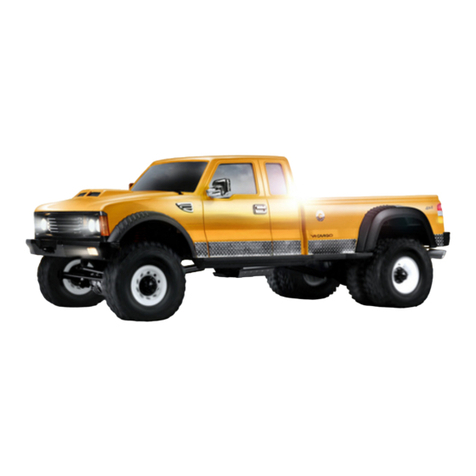
CROSSRC
CROSSRC PG4L user manual
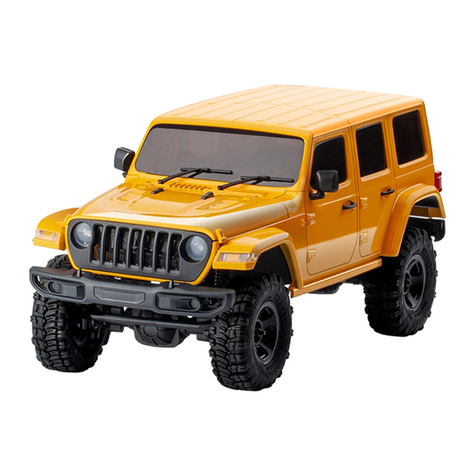
Eazy RC
Eazy RC Arizona instruction manual
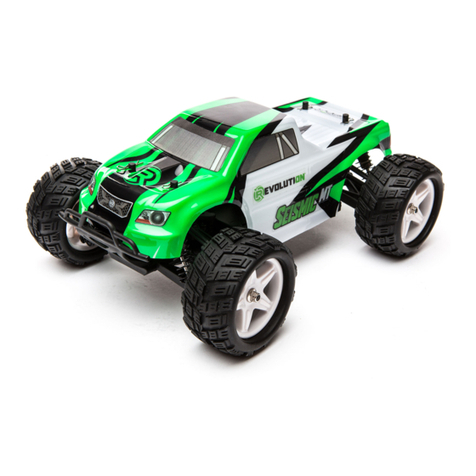
R/Evolution
R/Evolution SEISMIC MT 1:18 4WD RTR MONSTER TRUCK instruction manual
